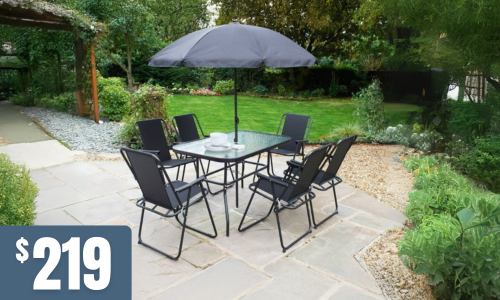Posts tagged with 'modern sophistication'
 In the realm of interior design, geometry serves as more than a mathematical concept; it emerges as a potent tool for creating visually arresting and organized living spaces. The prominence of geometric design in furniture has been steadily increasing, and its appeal is evident. With clean lines, precise angles, and harmonious patterns, geometric furniture effortlessly introduces structure and a modern aesthetic to your décor. In this article, we will delve into the allure of geometric design in furniture and explore how it can impart a sense of organisation to your living spaces.
In the realm of interior design, geometry serves as more than a mathematical concept; it emerges as a potent tool for creating visually arresting and organized living spaces. The prominence of geometric design in furniture has been steadily increasing, and its appeal is evident. With clean lines, precise angles, and harmonious patterns, geometric furniture effortlessly introduces structure and a modern aesthetic to your décor. In this article, we will delve into the allure of geometric design in furniture and explore how it can impart a sense of organisation to your living spaces.
Geometry in Furniture: A Time-Honoured Aesthetic:
The influence of geometry has pervaded furniture design for centuries, drawing inspiration from various architectural and design movements. From the iconic zigzags and chevrons of the Art Deco era to the clean lines of mid-century modernism, geometric patterns have etched their mark on the landscape of furniture design. Today, this design ethos is experiencing a revival, with geometric furniture taking centre stage in contemporary interior design.
Essential Elements of Geometric Furniture:
- Sleek Lines: Geometric furniture is characterised by its clean, straight lines. Whether it takes the form of a rectangular coffee table, a square bookshelf, or a triangular side table, these shapes contribute to the structured and orderly appearance of the furniture.
- Symmetry: Symmetrical patterns, such as repeated squares, circles, or hexagons, frequently feature prominently in geometric furniture. This symmetrical balance imbues the design with a sense of order and harmony.
- Contrast: Geometric furniture often relies on the interplay of contrasting elements, which may involve contrasting colours, materials, or shapes. These contrasts introduce visual interest and elevate geometric furniture pieces.
- Modularity: Many geometric furniture pieces are designed with modularity in mind. This means that you can rearrange or combine them to adapt to changing needs, enhancing the versatility of your décor.
Versatility of Geometric Furniture:
One of the most appealing aspects of geometric furniture is its versatility. It can seamlessly complement a wide range of interior design styles, from minimalistic and contemporary to industrial and retro. Here are some examples of how geometric furniture can enhance various living spaces:
- Living Room: Geometric coffee tables and shelving units can serve as captivating focal points, providing structure and functionality to your living area while offering a platform for showcasing your cherished décor items.
- Bedroom: A geometric bed frame or headboard can make a bold design statement, while geometric nightstands and dressers deliver storage solutions with a modern edge.
- Dining Area: Geometric dining tables and chairs can create an elegant, well-organised dining space, ideal for hosting guests.
- Home Office: Geometric desks and storage units not only offer a stylish workspace but also assist in maintaining an organised and clutter-free home office environment.
Pairing Geometric Furniture with Other Styles:
Geometric furniture can be seamlessly integrated with other design styles. For example, it can introduce structure and order to bohemian décor, introduce contrast in rustic settings, or enhance the sleekness of a contemporary space. Experiment with diverse combinations to strike the perfect balance that resonates with your personal style.
Geometric design in furniture transcends trends; it embodies a timeless aesthetic that infuses structure, equilibrium, and a contemporary allure into your décor. Whether you opt for a geometric coffee table as a statement piece or incorporate modular geometric shelving units for practical elegance, these pieces are poised to create a visual impact. Embrace the elegance of geometry in furniture design, and allow your décor to embody a sense of structure, harmony, and modern sophistication.
 Texture is a fundamental element of furniture design that often takes a back seat to considerations of colour, shape, and style. However, it's worth emphasising that texture plays a pivotal role in the overall aesthetic and tactile experience of furniture. In this exploration of texture in furniture design, we'll journey from the smooth to the rough, uncovering how different textures can transform your living spaces.
Texture is a fundamental element of furniture design that often takes a back seat to considerations of colour, shape, and style. However, it's worth emphasising that texture plays a pivotal role in the overall aesthetic and tactile experience of furniture. In this exploration of texture in furniture design, we'll journey from the smooth to the rough, uncovering how different textures can transform your living spaces.
The Allure of Smooth Surfaces
Smooth textures in furniture design convey a sense of refinement and sophistication. Pieces with glossy finishes, such as glass or polished wood, are a hallmark of modern and contemporary design. These surfaces create a sleek and seamless look that is not only visually pleasing but also easy to clean and maintain. Smooth textures can make small spaces feel more open and light, making them an excellent choice for minimalist interiors.
Embracing Softness with Upholstery
When it comes to seating and bedding, upholstery fabrics introduce a world of tactile textures. Soft and plush textures, like velvet and chenille, add an element of luxury and comfort to your furniture. These textures invite you to touch and sink into the furniture, creating a cosy and inviting atmosphere in your home. They are often chosen for sofas, armchairs, and headboards to enhance the tactile experience.
The Warmth of Wood
Wooden furniture offers a diverse range of textures, from the smooth grain of finely sanded wood to the more rugged and tactile feel of distressed or reclaimed wood. Smooth, polished wood exudes elegance and sophistication, while rougher wood textures can infuse a sense of warmth and character into your space. The choice of wood texture can significantly impact the overall style of your furniture, from sleek and modern to rustic and cosy.
Rustic Charm with Distressed Finishes
Distressed textures have gained popularity in recent years for their ability to add a touch of vintage charm to contemporary spaces. Whether it's a weathered paint finish on a cabinet or the distressed look of reclaimed wood on a dining table, these textures tell a story of time and history. They create a sense of nostalgia and authenticity in your interior design, making your furniture pieces feel like cherished heirlooms.
Metallic Textures for a Contemporary Edge
Metallic finishes, such as brushed stainless steel or hammered copper, introduce a unique textural element to furniture design. These textures are often associated with modern and industrial styles, adding a touch of urban chic to your home. They can be used for table legs, lighting fixtures, or accents on furniture pieces, providing a cool and edgy vibe.
Combining Textures for Depth
The most captivating furniture designs often incorporate a combination of textures to create depth and visual interest. For example, a smooth glass tabletop paired with leather-upholstered chairs and a distressed wood base can create a harmonious blend of textures that appeals to both the eye and the senses.
Texture in furniture design is more than just a visual element; it's a sensory experience. From the smooth, glossy surfaces of modern design to the rugged, weathered textures of rustic charm, the choice of texture can significantly impact the look and feel of your living spaces. When selecting furniture for your home, consider how different textures can work together to create a harmonious and inviting environment that reflects your personal style and preferences. Whether you lean towards sleek and modern or embrace the warmth of rough textures, your furniture choices can tell a unique story of your design sensibilities.




.jpeg)

 (3).jpeg)
